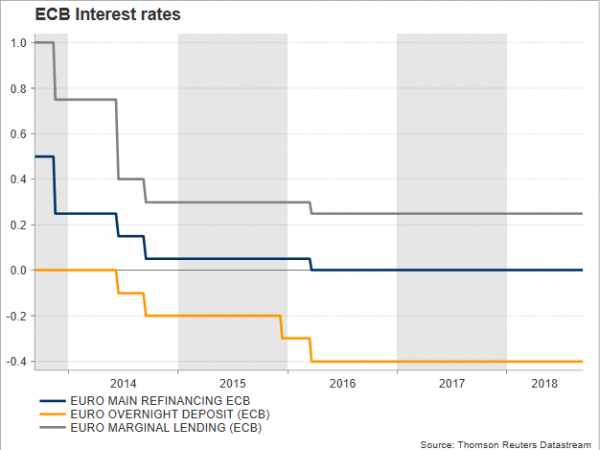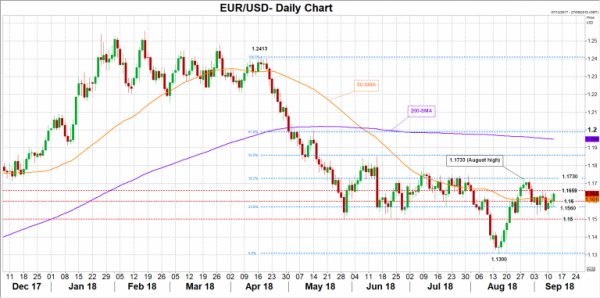On Thursday the European Central Bank (ECB) is expected to have another non-event policy meeting at 1145 GMT as policymakers have already laid down the path of monetary policy for the next year. The meeting, however, could bring a wave of volatility to the euro if the ECB elevates worries about the US trade strategy and calls for caution regarding political matters in Italy. Positioning on the common currency could also alter based on the central bank’s new economic projections.
At July’s meeting, the ECB reiterated that key interest rates will remain unchanged at least through the summer of 2019 – as was agreed in June – while the central bank will continue to make net asset purchases at the monthly pace of 30 billion euros until the end of September 2018. It also guided that beyond September 2018 and if upcoming data are broadly in line with the central bank’s inflation forecasts, the amount of monthly net asset purchases will decline to 15 billion euros before the quantitative easing program comes to end in December. Indeed, initial estimates on consumer prices for the month of August showed that the headline inflation managed to stand at 2.0%, just above the central bank’s price target, a factor that could allow policymakers to proceed with their remaining QE plans. Recall that the ECB estimates inflation to come in at 1.7% across 2018 to 2020.
Yet the idea that the trade war between the US and China, the world’s two largest economies, may turn into something stronger in the future, could weigh on policymakers’ sentiment and thus on the Bank’s new economic projections delivered together with the rate announcement. According to the latest forecasts unveiled in June, the ECB believes that real GDP growth in the single market will stand at 2.1% at the end of 2018, while for the next two years expansion is anticipated to slow down to 1.9% and 1.7% respectively. While there is not yet clear evidence that US trade frictions have started to pressure the bloc’s business activities, given that the Eurozone Markit Manufacturing PMI weakened in August, but the composite PMI improved, policymakers could still think that a potential escalation in the already inflamed trade tensions may weigh on activity in the future. Therefore, taking into account that Washington may take stricter measures against Beijing, potentially unleashing additional tariffs on $200 billion Chinese products, policymakers may consider previous growth prospects overestimated. Especially if they judge that emerging markets, where debt is denominated in dollars and major European banks serve a considerable amount of loans, have more to lose in the wake of a stronger trade war. Note that the dollar managed to remain resilient to rising trade risks recently on the back of optimism on the US economy and high expectations of further monetary tightening by the Fed this year.
Besides trade, Italy could be another highlight of the central bank’s agenda. Italian politics have been on the wires quite often recently, turning the euro and Italian stocks upside down on fears that fiscal reforms proposed by the new coalition government are violating European spending rules. Earlier this week the Italian Minister of Economy and the Deputy Prime Minister calmed markets that Italy’s budget awaited in draft form at the end of September will respect European debt settings. Today, however, reports that the leader of the coalition Five-Star Movement would seek the resignation of the Minister of Economy if the basic income proposal worth 10 billion euros is not included in the budget, revived worries that divisions in the government remain. That also signaled that a budget leading to a public deficit above the EU’s 3.0% limit is possible.
In the FX markets, euro/dollar is struggling to hold above 1.1600 as a combination of trade risks, noisy political conditions in Italy and weakness in emerging markets refrain investors from increasing exposure to the euro. A positive message by the ECB on Thursday however – probably indicating that the central bank holds optimistic on the bloc’s inflation and growth path – could raise interest for the common currency sending the pair towards September 9’s high of 1.1659. Above from there, bullish actions could target the August peak of 1.1733 where the 38.2% Fibonacci of the downleg from 1.2413 to 1.1300 is also placed.
Alternatively, if the ECB puts more weight on political and trade uncertainties than analysts currently price in, potentially downgrading its economic projections, the price could drop back below 1.1600 to test the 23.6% Fibonacci of 1.1560, before it visits the 1.1500 mark.
The ECB chief, Mario Draghi, will hold a press conference at 1230 GMT.













